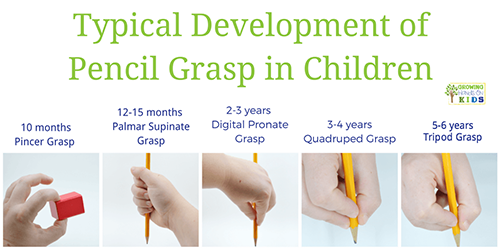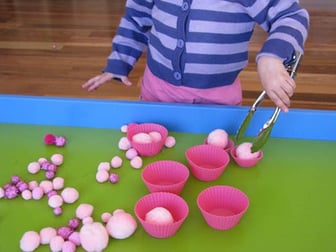
The term ‘fine motor’ refers to the use of the small muscles of the body. Any part of the body that uses small muscles, such as hands, wrists, fingers, feet, toes, lips, mouth and tongue, are covered by the term ‘fine motor’.
Fine motor control develops in the growing child, from infancy through into the early years of primary school, and relies upon the age appropriate development of physical skills (such as core trunk control and shoulder strength) providing the stable base from which the smaller body parts can then move with control.
What is normal?
By the time a child reaches school age their fine motor skills should be developed to a stage where they are independent in self-care skills such as dressing, eating and toileting. They should be able to do up buttons and zips on clothing, tie shoe laces (or at least be able to manipulate the laces and tie with some help), open lunch boxes, drink bottles and pencil cases.
They also require a level of development that will allow them to engage with learning activities such as cutting, writing, drawing and manipulating small objects. These are core skills that will be used daily in a classroom environment and whilst it is not necessary that a child can write correctly spelt words, children must be able to hold a pencil correctly for a sustained period of time.
If a child does not have these skills, or is experiencing difficulty with these skills, they may suffer frustration because they are unable to perform tasks as competently as their peers. It is often the case that a child struggling in this area will avoid tasks involving fine motor skills due to the frustration, fatigue or fear of failure that is experienced at each attempt.
Where to go for help
So what should you do if you suspect that your child may be struggling in this area? The best place to start is with your child’s teacher, to get a picture of how your child is approaching and managing tasks involving fine motor skills. If you think that further support is needed, see your GP or find an Occupational Therapist in your area (no referral is needed) who works with young children.
I did just that before my daughter started school. I had concerns, because at the age of four she was still holding her pencil predominantly with a whole-hand fist grip and rarely using her fingers. She also struggled to hold scissors in her hand and to cut on a line or to pick up and hold a number of small objects in her hand at one time. Skills that I knew would be vital to her learning in a school setting.

So off we went to see an Occupational Therapist (OT) who assessed and then demonstrated a number of activities we could do at home to encourage the correct development of fine motor skills relating to hands. Shared below are the specific skills that our OT focused on developing and some fun ways to help develop each skill.
Activities to develop fine motor skills
Hand and Finger Strength
Building strength in hands and fingers by using object that create resistance such as pegs, clips and training chopsticks.

- paint using pegs holding cotton wool balls as brushes
- pretend pegs are birds and short pieces of pipe cleaners are worms to catch
- match coloured pegs to coloured card
- hang up some washing
- eat with chopsticks
- pinch off small amounts of playdough and roll into lots of tiny balls
- play with squeezy bath toys or water pistols
- cut and scrunch tissue paper into small balls – make a collage picture
- hide small plastic toys or beads in playdough and have child find and extract them
- make pizza dough – just as much fun as playdough and edible!
Bilateral Integration
Using both hands to perform a task, not just one. Using the terms ‘working hand’ and ‘helping hand’ - the ‘helping hand’ holds while the ‘working hand’ does the work.
- cutting along lines – straight and curved
- sewing and threading activities
- pushing pipe cleaners or straws through a colander
- punch holes in card using a hand held hole punch
- scoop ice cream into a cone
Finger Isolation
Using just one or two fingers at a time to complete a task.
- flipping frog game
- poking objects through small holes; ie: pushing pom poms through an open weave basket
- mini Twister game
- fingerprint painting, one finger at a time
- playing with finger puppets
Have some fun with these and please share below any other ideas you may have.










